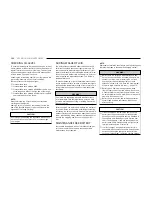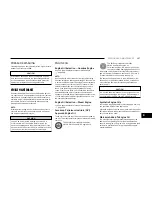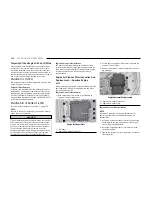
CHARGE AIR COOLER —
INTER-COOLER
The charge air cooler is positioned below the radiator
and the air conditioner condenser. Air enters the engine
through the air cleaner and passes through the turbo-
charger, where it is pressurized. This pressurized air
rapidly reaches high temperature. The air is then
directed through a hose to the charge air cooler and
through another hose to the intake manifold of the
engine. The air entering the engine has been cooled by
about 50° to 100°F (10° to 38°C). This cooling pro-
cess enables more efficient burning of fuel resulting in
fewer emissions.
To guarantee optimum performance of the system,
keep the surfaces of the charge air cooler, condenser
and radiator clean and free of debris. Periodically check
the hoses leading to and from the charge air cooler for
cracks or loose clamps resulting in loss of pressure and
reduced engine performance.
BRAKE SYSTEM
In order to ensure brake system performance, all brake
system components should be inspected periodically
WARNING!
Riding the brakes can lead to brake failure and possi-
bly a collision. Driving with your foot resting or riding
on the brake pedal can result in abnormally high
brake temperatures, excessive lining wear, and pos-
sible brake damage. You would not have your full
braking capacity in an emergency.
Fluid Level Check — Brake Master
Cylinder
The fluid level of the master cylinder should be checked
when performing under the hood service or immedi-
ately if the Brake System Warning Light indicates sys-
tem failure.
If necessary, add fluid to bring level within the desig-
nated marks on the side of the reservoir of the brake
master cylinder. Be sure to clean the top of the master
cylinder area before removing cap.
With disc brakes the fluid level can be expected to fall
as the brake linings wear. However, an unexpected drop
in fluid level may be caused by a leak and a system
check should be conducted.
For further information
WARNING!
•
Use only manufacturer's recommended brake fluid
page 340. Using the wrong type of brake fluid
can severely damage your brake system and/or
impair its performance. The proper type of brake
fluid for your vehicle is also identified on the origi-
nal factory installed hydraulic master cylinder
reservoir.
•
To avoid contamination from foreign matter or
moisture, use only new brake fluid or fluid that has
been in a tightly closed container. Keep the master
cylinder reservoir cap secured at all times. Brake
fluid in an open container absorbs moisture from
the air resulting in a lower boiling point. This may
cause it to boil unexpectedly during hard or pro-
longed braking, resulting in sudden brake failure.
This could result in a collision.
(Continued)
WARNING!
•
Overfilling the brake fluid reservoir can result in
spilling brake fluid on hot engine parts, causing
the brake fluid to catch fire. Brake fluid can also
damage painted and vinyl surfaces, care should be
taken to avoid its contact with these surfaces.
•
Do not allow petroleum based fluid to contaminate
the brake fluid. Brake seal components could be
damaged, causing partial or complete brake fail-
ure. This could result in a collision.
AUTOMATIC TRANSMISSION
Special Additives
The manufacturer strongly recommends against using
any special additives in the transmission. Automatic
Transmission Fluid (ATF) is an engineered product and
its performance may be impaired by supplemental addi-
tives. Therefore, do not add any fluid additives to the
transmission. The only exception to this policy is the
use of special dyes for diagnosing fluid leaks in 6-speed
transmissions. Avoid using transmission sealers as they
may adversely affect seals.
CAUTION!
Do not use chemical flushes in your transmission as
the chemicals can damage your transmission compo-
nents. Such damage is not covered by the New
Vehicle Limited Warranty.
300
SERVICING AND MAINTENANCE
Summary of Contents for CHASSIS CAB 2024
Page 69: ...GETTING TO KNOW YOUR INSTRUMENT PANEL MIDLINE INSTRUMENT CLUSTER GASOLINE 67 3...
Page 71: ...HIGHLINE INSTRUMENT CLUSTER GASOLINE GETTING TO KNOW YOUR INSTRUMENT PANEL 69 3...
Page 75: ...MIDLINE INSTRUMENT CLUSTER DIESEL GETTING TO KNOW YOUR INSTRUMENT PANEL 73 3...
Page 77: ...HIGHLINE INSTRUMENT CLUSTER DIESEL GETTING TO KNOW YOUR INSTRUMENT PANEL 75 3...
Page 357: ......
Page 358: ......










































